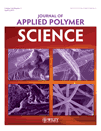Controlled mechanical and swelling properties of poly(vinyl alcohol)/sodium alginate blend hydrogels prepared by freeze–thaw followed by Ca2+ crosslinking
Abstract
Poly(vinyl alcohol) (PVA)/sodium alginate (SA) blend hydrogels have immense potential for use as functional biomaterials. Understanding of influences of processing parameters and compositions on mechanical and swelling properties of PVA/SA blend hydrogels is very important. In this work, PVA/SA blend hydrogels with different SA contents were prepared by applying freeze–thaw method first to induce physical crosslinking of PVA chains and then followed by Ca2+ crosslinking SA chains to form interpenetrating networks of PVA and SA. The effects of number of freeze–thaw cycles, SA content and Ca2+ concentration on mechanical properties, swelling kinetics, and pH-sensitivity of the blend hydrogels were investigated. The results showed that the blend hydrogels have porous sponge structure. Gel fraction, which is related to crosslink density of the blend hydrogels, increased with the increase of freeze–thaw cycles and strongly depended on SA content. The SA content exerts a significant effect on mechanical properties, swelling kinetics, and pH-sensitivity of the blend hydrogels. The number of freeze–thaw cycles has marked impact on mechanical properties, but no obvious effect on the pH-sensitivity of the PVA/SA blend hydrogels. Concentration of CaCl2 aqueous solution also influences mechanical properties and pH-sensitivity of the blend hydrogel. By altering composition and processing parameters such as freeze–thaw cycles and concentration of CaCl2 aqueous solution, the mechanical properties and pH-sensitivity of PVA/SA blend hydrogels can be tightly controlled. © 2011 Wiley Periodicals, Inc. J Appl Polym Sci, 2012




